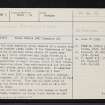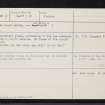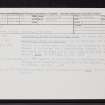Pricing Change
New pricing for orders of material from this site will come into place shortly. Charges for supply of digital images, digitisation on demand, prints and licensing will be altered.
Gaulcross North
Stone Circle (Neolithic) - (Bronze Age), Hoard (Silver)(Pictish)
Site Name Gaulcross North
Classification Stone Circle (Neolithic) - (Bronze Age), Hoard (Silver)(Pictish)
Alternative Name(s) Ley
Canmore ID 17979
Site Number NJ56SW 11
NGR NJ 5354 6392
Datum OSGB36 - NGR
Permalink http://canmore.org.uk/site/17979
- Council Aberdeenshire
- Parish Fordyce
- Former Region Grampian
- Former District Banff And Buchan
- Former County Banffshire
NJ56SW 11 5354 6392.
(NJ 5354 6392) Stone Circle (NR) (Remains of)
OS 6" map, Banffshire, 2nd ed., (1905)
Only the most westerly stone remains of a circle that stood a few hundred yards north of the farm-house of Ley. It was similar to another stone circle 50 yards away (NJ56SW 10) which comprised six large stones in a circle, 60 feet in diameter, surrounded by an outer ring of large quantities of small stones, about 16 feet broad.
The remaining stone lies semi-prostrate and propped up with small stones under its western end. It measures approximately 6 feet by 3 feet 3 inches by 2 feet.
About the year 1830 a chain and possible buckles, pins and brooches, all of silver, were found about 18 feet south-east of the stone. They are all much later in period than the stone and one of the pins is of a 2nd century AD type.
This pin and the chain are in the museum at Banff both described, however, as being found beside an urn. (For an urn found nearby, see NJ56SW 17.)
F R Coles 1904; 1906; W Cramond 1887.
The silver objects found at Gaulcross are of Pictish origin - possibly 8th century AD.
R B K Stevenson 1955.
One recumbent stone, conforming to the measurements in Coles (1906), still remains. No trace of the circle can be found.
The silver pin and chain are still in the Banff museum.
Visited by OS (WDJ) 18 September 1961.
No change - copies of silver objects in Banff Museum.
Visited by OS (NKB) 7 July 1967.
This stone has been destroyed.
Visited by OS (AGF) September 1991.
Publication Account (2011)
Two stone circles formerly stood in the field on the crest of the hill a little over 200m north-north-east of Ley, each apparently comprising six orthostats erected along the line of a stony ring-bank. Save a single stone of the northern circle left as a rubbing stone (Cramond 1884, 92–3), most of the orthostats were blown up to provide materials to build the farmhouse and steading (Stuart 1867, 74–5; Name Book, Aberdeenshire, No. 12, p 56), and even this stone has now been removed. The date the circles were demolished is not altogether certain, but about 1838 or shortly after, both were trenched to improve the ground and remove the smaller stones that still remained. This led to the discovery of the well-known Gaulcross hoard of Pictish silver close to the single orthostat that had been left standing on the northern circle. The circles were first noted by Thomas Pennant, who refers to them as ‘the two circles of long stones called Gael–cross’ (1774, 140), but the most complete description is provided by John Stuart almost a hundred years later. He had his information from the tenant of the farm, James Lawtie, whose father had taken the lease in 1837 and soon after had begun improving the ground. While Lawtie remembered these improvements himself, the majority of the orthostats had probably been removed by then, for he could only relay to Stuart what an old man had told him about them. Thus, most of this description is at second or third hand. Nevertheless, the un-named old man recalled: ‘The one was about forty yards [36.5m] and the other about thirty-five yards [32m] in diameter, and … there were six pillars in each circle. These pillars were placed in a circular foundation of small boulders about thirty foot [9m] broad and two [0.6m] deep’. Lawtie continued: ‘Only one now remains of all the pillars. It marks the site of the circle that stood to the north. In the course of trenching the area of this circle about twenty years ago, the workmen found the silver chain and pin… between two stones… at a spot not far from the pillar (which still remains) on the south side of the circle … under and towards the centre of the circular belt of small stones in which the large pillars stood. On the opposite side of the circle was a large flat slab of limestone about seven feet long and three in breadth…[and] below it there was a thin layer of darkish greasy earth, which rested upon the common soil’ (Stuart 1867, 74–5). Apart from the hoard of Pictish silver, nothing else was found and it is clear that Lawtie’s expectations of burning and burials, and perhaps some kind of entrance, were disappointed. Lawtie also appears first in the list of three authorities consulted by OS surveyors for the terse description that appears in the Name Book (Banffshire, No. 12, p 56). He presumably pointed out the sites of the two rings, though Rev William Cramond, guiding a party of the Banffshire Field Club in September 1884, claimed that the outlines of both were still visible, lying about 45m apart. The additional details that Cramond supplies are therefore probably born of his own observations and those of Lawtie, who was still in the farm at that time (Cramond 1884, 93): the southern had ‘an outer ring of smaller stones, covering the ground irregularly in large quantities to a breadth of some 16 feet [5m]. Six large blocks of stone marked the circle proper, the diameter of which was about 60 feet [18m]’ (ibid 92). Of the northern circle he was less forthcoming, other than it was similar, but he located the surviving stone on the west of the circle, and the discovery of the Pictish hoard 5.5m south-east of it. The stone had fallen by the date of Coles’ visit, but he measured and sketched it where it lay, recording that it was 1.8m long by 1m broad and up to 0.6m thick (1906a, 187–9). It remained there until at least 1967 when Keith Blood of the OS visited the site. Both these circles seem to have been unusual monuments. We should not perhaps place too much weight on the count of six stones in each, but it is otherwise clear that the ring-banks formed substantial bands of cairn material and, designated an ‘outer ring’ by Cramond, that they extended well outside the orthostats. The absence of any entrances through the ring-banks is possibly also telling, for were these merely the stumps of large robbed cairns there would usually have been a gap broken through the perimeter to allow the passage of carts in and out of the central quarry. Parallels for rings of orthostats set in ring-banks can be found amongst the recumbent stone circles, such as at North Strone, but the absence of any detailed description of the orthostats and no mention of anything that might have been a recumbent setting on the southern arc precludes such an identification for either of the rings here. This was certainly Barnatt’s view of Gaulcross North (1989, 461, no. 6:130), but Ruggles included it in his supplementary list of recumbent stone circles (1999, 188), perhaps as a result of misunderstanding the report submitted in 1961 by William Johnston, an OS field investigator, who unfortunately described the last surviving orthostat as a recumbent stone. In the case of Gaulcross South, however, where Cramond produced a more convincing assessment of its diameter, Barnatt has suggested that this was more consistent with that of a recumbent stone circle than the six-stone ring postulated by Burl (1976a, 355, Ban 3; 2000, 424, Ban 3; Barnatt 1989, 284–5, no. 6:44). Unfortunately Burl has mistakenly associated the discovery of the Pictish silver hoard with Gaulcross South in the latest recension of his list.
Excavation (March 2013 - October 2014)
NJ 5354 6392 As part of the Northern Picts Project surveys and excavations have been undertaken in an area stretching from Aberdeenshire to Easter Ross targeting sites that can help contextualize the character of society in the early medieval period in northern Pictland.
In 1838, on the Ley Farm a silver hoard dating to the Pictish period was discovered. The 19th-century accounts suggest numerous items were found, but of these artefacts only three survive today in the National Museum of Scotland. The silver hoard was buried in association with Gaulcross North, one of two stone circles which were removed in the 1830s when the silver hoard was found.
In March 2013 a geophysical survey was conducted in the field where the stone circles and the hoard were found but no features were discovered. At the same time a metal detector survey was conducted and with this method over 80 silver pieces were discovered in the ploughsoil, mapped and recorded. Following these surveys a 30 x 30m trench was opened where the densest concentration of artefacts was located. This trench revealed a single shallow feature close to the centre of the artefact distribution. However, no in situ silver or datable deposits were found. Close to this feature another small feature was discovered which contained small fragments of cremated bone. Charcoal from this feature was dated to the Early Iron Age (SUERC-48413 2473±34; 765–415 cal BC 95.4%).
A second trench (5 x 5m) was opened over the location of the northern stone circle. This trench was targeted to try and identify the last recorded position of the final standing stone of Gaulcross North stone circle. In the trench few cut features were recorded. Two of these were shallow pits containing stones and charcoal. The charcoal fill in one of the pits has been
dated to the early 4th millennium BC (SUERC-48408 5073±34; 3960–3790 cal BC 95.4%), the adjacent pit fill has been dated to the Mid Bronze Age (SUERC-48409 3302±34; 1670–1500 cal BC 95.4%). This later pit may be related to the stone circle.
Another 12 x 25m trench was subsequently excavated in October 2014 to link the previous two trenches and to cover the projected position of the original silver finds as recorded by Cramond in the 1860s. No silver objects were found and only three small pit features were discovered and await dating and analysis. Two of these pit features contained datable material.
Archive: University of Aberdeen
Funder: University of Aberdeen Development Trust in partnership with the Tarbat Discovery Centre
Gordon Noble, Martin Goldberg, Oskar G Sveinbjarnarson and Alistair Mcpherson – University of Aberdeen and National Museum Scotland
(Source: DES)












